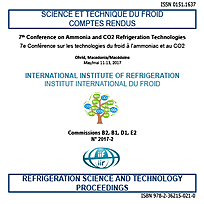
IIR document
Reduction of energy consumption by applying a new generation of CO2 compressors.
Number: pap. n. 0019
Author(s) : JAVERSCHEK O., PFAFFL J., KARBINER J.
Summary
The development of transcritical CO2 systems in commercial refrigeration can be considered to be in a transition phase from cutting edge to state-of-the-art technology. However, the stress field of new developments is strong and characterized by challenging demands from the market: Further improvement of the annual energy efficiency, reduced system complexity and a decreased cost of ownership. One key to success in commercial refrigeration is the application of a new generation of energy efficient CO2 compressors in a so-called baseline system. The features of this highly efficient compressor range, which is called ECOLINE+, is explained in this paper. The European standard EN13215 is considered as the standard method for the evaluation of the annual energy efficiencies. A more complex and time consuming method to calculate the annual energy efficiency is to consider the prevailing climate, more specific load profiles, the system configuration, operating times and resulting operating conditions of the compressors applied. This work provides an analytical study of different methods to calculate the annual energy efficiency for the new compressor generation compared to the standard compressor range and discusses the results of the comparison.
Available documents
Format PDF
Pages: 8
Available
Public price
20 €
Member price*
Free
* Best rate depending on membership category (see the detailed benefits of individual and corporate memberships).
Details
- Original title: Reduction of energy consumption by applying a new generation of CO2 compressors.
- Record ID : 30021630
- Languages: English
- Subject: Technology
- Source: 7th Conference on Ammonia and CO2 Refrigeration Technology. Proceedings: Ohrid, North Macedonia, May 11-13, 2017.
- Publication date: 2017/05/11
- DOI: http://dx.doi.org/10.18462/iir.nh3-co2.2017.0019
Links
See other articles from the proceedings (42)
See the conference proceedings
Indexing
-
Efficiency analysis and comparison of innovativ...
- Author(s) : WIEDENMANN E., SCHOENENBERGER J., BAERTSCH M.
- Date : 2014/08/02
- Languages : English
- Source: 11th IIR Gustav Lorentzen Conference on Natural Refrigerants (GL2014). Proceedings. Hangzhou, China, August 31-September 2, 2014.
- Formats : PDF
View record
-
Heat recovery performance of an integrated CO
- Author(s) : SICCO E., TOFFOLETTI G., D'AGARO P., CORTELLA G.
- Date : 2024/08
- Languages : English
- Source: 16th IIR-Gustav Lorentzen Conference on Natural Refrigerants (GL2024). Proceedings. University of Maryland, College Park, Maryland, USA, August 11-14 2024
- Formats : PDF
View record
-
Influence of cooling load profile on the predic...
- Author(s) : D'AGARO P., LIBRALATO M., TOFFOLETTI G., CORTELLA G.
- Date : 2022/06/13
- Languages : English
- Source: 15th IIR-Gustav Lorentzen Conference on Natural Refrigerants (GL2022). Proceedings. Trondheim, Norway, June 13-15th 2022.
- Formats : PDF
View record
-
Preventing transcritical operation of CO2 refri...
- Author(s) : LEIPER A., SKELTON J., RIVERS N., et al.
- Date : 2014/06/23
- Languages : English
- Source: 3rd IIR International Conference on Sustainability and the Cold Chain. Proceedings: London, UK, June 23-25, 2014
- Formats : PDF
View record
-
Comparison of state-of-the-art CO2 alternative ...
- Author(s) : KARAMPOUR M., SAWALHA S.
- Date : 2018/06/18
- Languages : English
- Source: 13th IIR Gustav Lorentzen Conference on Natural Refrigerants (GL2018). Proceedings. Valencia, Spain, June 18-20th 2018.
- Formats : PDF
View record
